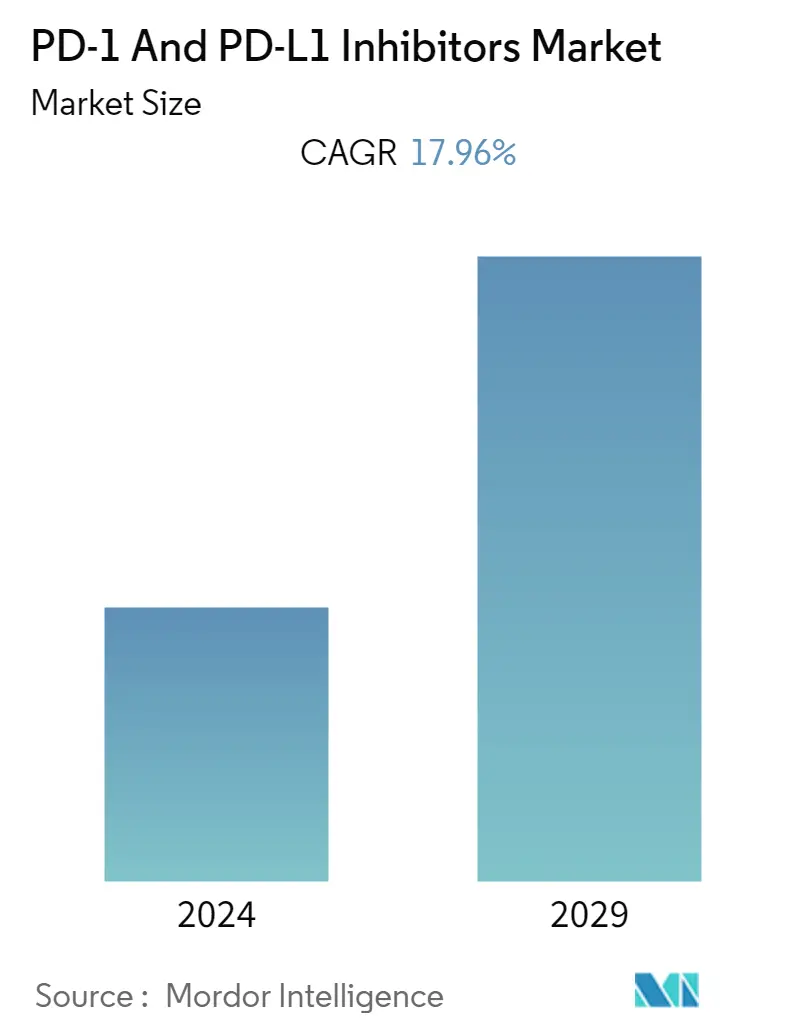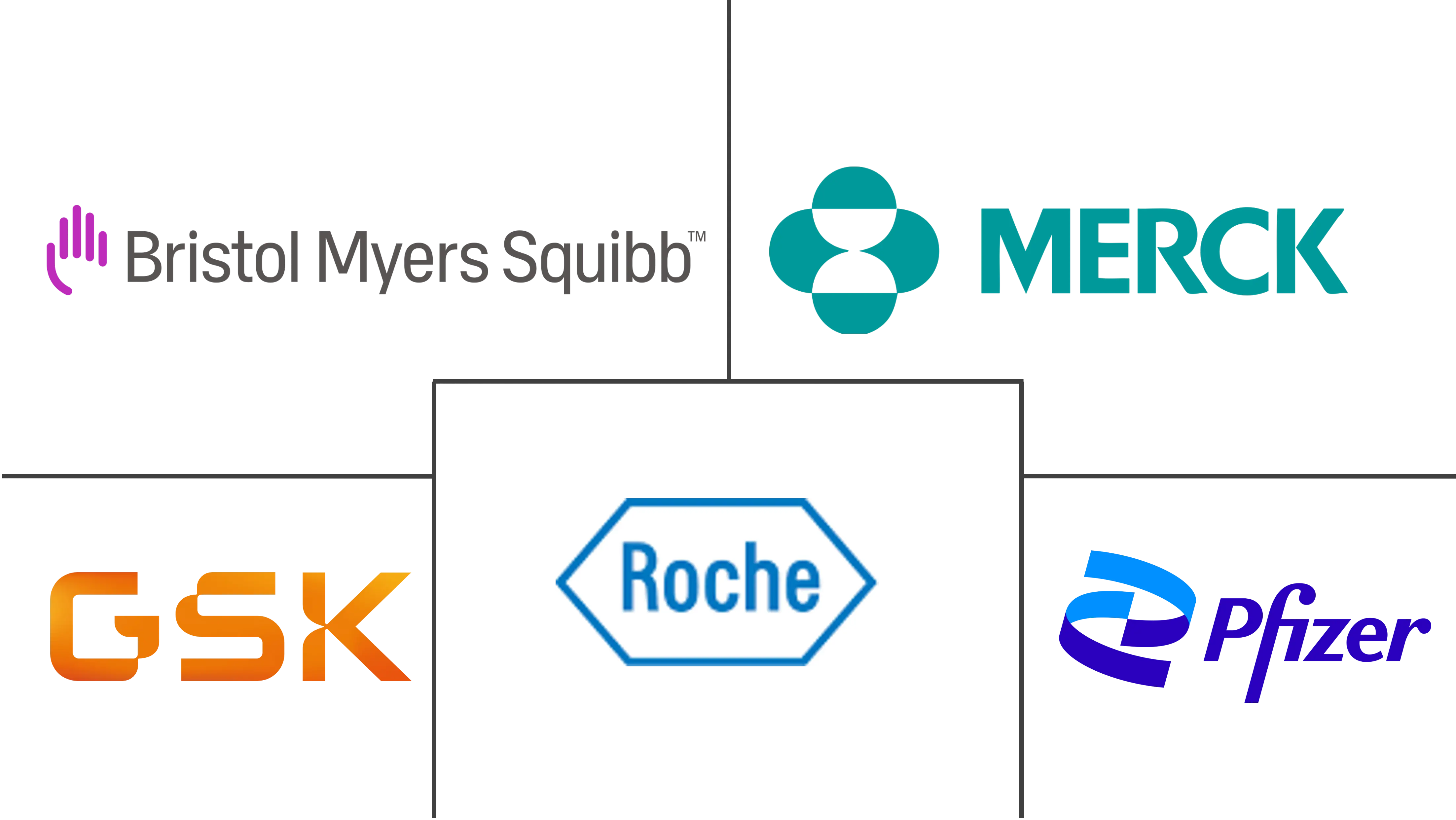Market Size of PD-1 And PD-L1 Inhibitors Industry

| Study Period | 2019 - 2029 |
| Base Year For Estimation | 2023 |
| CAGR | 17.96 % |
| Fastest Growing Market | Asia Pacific |
| Largest Market | North America |
| Market Concentration | High |
Major Players
*Disclaimer: Major Players sorted in no particular order |
Need a report that reflects how COVID-19 has impacted this market and its growth?
PD-1 and PD-L1 Inhibitors Market Analysis
The PD-1 and PD-L1 inhibitors market is estimated at USD 45.80 billion in 2023. It is expected to reach USD 104.59 billion by 2028, with a CAGR of 17.96% during the forecast period.
- The COVID-19 pandemic has caused widespread disruption in cancer care, including delays in diagnosis and treatment, as well as the suspension of clinical trials in the initial phase of the pandemic. For instance, according to the article published in the National Library of Medicine in June 2022, there was a decrease or delay in oncologic surgical procedures, cancer screening tests, and clinic visits and a significant decline in newly identified patients with cancer in the initial phase of the pandemic. As PD-1 and PD-L1 inhibitors are used explicitly in cancer treatments, the market growth witnessed a slight decline amid the outbreak. Additionally, delay, withdrawal, and decline of FDA approval for the PD-1 and PD-L1 drug therapy also impacted the studied market. For instance, in July 2022, BeiGene reported the delay in new PD-1 cancer immunotherapies, tislelizumab, in previously treated oesophageal squamous cell carcinoma (ESCC). The FDA solely mentioned COVID-related travel limitations as the reason for the agency's inability to conduct inspections in China. Delays in drug approval and site inspection by the FDA, a decline in clinical research, and delayed cancer treatment during COVID-19 all significantly impacted the market. However, with several government initiatives and research demonstrating the safety of PD-1 and PD-L1 inhibitor therapy in COVID-19 patients following immunization, the market gained notable pace in the latter phase of the pandemic and is likely to continue this trend over the coming years, as per the analysis.
- Factors such as rising investments in research and development (R&D), clinical trials by bio-pharmaceutical industries, growth in initiatives by the regulatory authorities for speedy approvals, and the growing burden of different cancers are anticipated to fuel the overall studied market growth. Several companies and research institutions have been focused on developing new PD-1 inhibitors to treat various cancers. For instance, in March 2022, Jacobio reported an RMB 421 million (USD 5.89 million) R&D expenditure, representing an 83% increase over 2021. The company concluded the phase I clinical investigation of AB-3312, and the recommended dose of monotherapy and combination therapy with PD-1 inhibitor has been determined. This surge in trials highlights the growth in research and development activities in the PD-1 and PD-L1 inhibitors market space, signifying a robust pipeline of therapies and encouraging further exploration of novel therapeutic approaches, boosting the market growth.
- The increasing cases of cancer across the globe are one of the major factors bolstering the market growth over the forecast period. For instance, as per the report published by the WHO in February 2022, around 400,000 children develop cancer each year, and the common type of cancer varies country-wise. Similarly, as per the report published by the American Cancer Society in January 2023, around 1.9 million people are expected to suffer from cancer in the United States by the end of 2023. A protein found in T cells (immune cells) helps manage the body's immune responses. When PD-1 binds to another protein called PD-L1, it helps to prevent T cells from killing other cells, including cancer cells. Therefore, increasing cancer cases are anticipated to propel the demand for PD-1 and PD-L1 inhibitors owing to their promising outcomes, thereby surging the market growth over the forecast period.
- Moreover, several approvals and clinical trial activities by key players are expected to boost the market's growth. For instance, in February 2023, the China National Medical Products Administration (NMPA) approved BeiGene's PD-1 inhibitor, tislelizumab, in combination with fluoropyrimidine and platinum chemotherapy, for the first-line treatment of patients with locally advanced unresectable or metastatic G/GEJ adenocarcinoma with high PD-L1 expression. Similarly, in November 2022, the FDA approved cemiplimab in combination with platinum-based chemotherapy as first-line therapy in adult patients with advanced NSCLC harboring no EGFR, ALK, or ROS1 mutations. In addition, as of June 2023, nearly 841 clinical trials were registered for PD-1 inhibitors and 606 clinical trials for PD-L1 inhibitors for cancer. Thus, with the growing number of product approvals and clinical trials, the market is expected to grow considerably over the forecast period.
- Hence, increasing research and development activities coupled with a growing number of cancer cases and drug approvals are expected to boost the market growth over the forecast period. However, the high risk of complications associated with the highly expensive oncology treatment and challenges in development with uncertainty in the regulatory process and high costs of clinical trials are likely to restrain the market growth over the forecast period.
